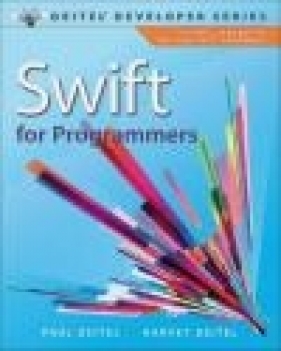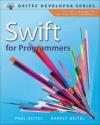Swift for Programmers
Harvey Deitel, Paul Deitel
Swift for Programmers
Harvey Deitel, Paul Deitel
- Wydawnictwo: Prentice Hall
- Rok wydania: 2015
- ISBN: 9780134021362
- Ilość stron: 400
- Oprawa: Miękka
Niedostępna
Opis: Swift for Programmers - Harvey Deitel, Paul Deitel
The professional programmer's Deitel(R) guide to Apple's new Swift programming language for the iOS(R) and OS X(R) platforms ' Written for programmers with a background in object-oriented programming in a C-based language like Objective-C, Java, C# or C++, this book applies the Deitel signature live-code approach with scores of complete, working, real-world programs to explore the new Swift language in depth. The code examples feature syntax shading, code highlighting, rich commenting, line-by-line code walkthroughs and live program outputs. The book features thousands of lines of proven Swift code, and tips that will help you build robust applications. ' Start with an introduction to Swift using an early classes and objects approach, then rapidly move on to more advanced topics. When you master the material, you'll be ready to build industrial-strength object-oriented Swift applications. About This Book ' The Swift(TM) programming language was arguably the most significant announcement at Apple's 2014 Worldwide Developers Conference. Although apps can still be developed in Objective-C(R), Apple says that Swift is its applications programming and systems programming language of the future. ' Swift is a contemporary language with simpler syntax than Objective-C. Because Swift is new, its designers were able to include popular programming language features from languages such as Objective-C, Java(TM), C#, Ruby, Python(R) and many others. These features include automatic reference counting (ARC), type inference, optionals, String interpolation, tuples, closures (lambdas), extensions, generics, operator overloading, functions with multiple return values, switch statement enhancements and more. We've been able to develop apps more quickly in Swift than with Objective-C and the code is shorter, clearer and runs faster on today's multi-core architectures. ' Swift also eliminates the possibility of many errors common in other languages, making your code more robust and secure. Some of these error-prevention features include no implicit conversions, ARC, no pointers, required braces around every control statement's body, assignment operators that do not return values, requiring initialization of all variables and constants before they're used, array bounds checking, automatic checking for overflow of integer calculations, and more. You can combine Swift and Objective-C in the same app to enhance existing Objective-C apps without having to rewrite all the code. Your apps will easily be able to interact with the Cocoa(R)/Cocoa Touch(R) frameworks, which are largely written in Objective-C. ' You can also use the new Xcode playgrounds with Swift. A playground is an Xcode window in which you can enter Swift code that compiles and executes as you type it. This allows you to see and hear your code's results as you write it, quickly find and fix errors, and conveniently experiment with features of Swift and the Cocoa/Cocoa Touch frameworks. ' Practical, Example-Rich Coverage of: * Classes, Objects, Methods, Properties* Initializers, Deinitializers, Bridging* Tuples, Array and Dictionary Collections* Structures, Enumerations, Closures, ARC* Inheritance, Polymorphism, Protocols* Type Methods, Type Properties* Generics; Strings and Characters* Operator Overloading, Operator Functions, Custom Operators, Subscripts* Access Control; Type Casting and Checking* Nested Types, Nested Methods* Optionals, Optional Chaining, Extensions* Xcode, Playgrounds, Intro to Cocoa Touch(R) with a Fully Coded iOS(R) 8 Tip Calculator App* Overflow Operators, Attributes, Patterns* More topics online ' IMPORTANT NOTE ABOUT XCODE AND SWIFT: With Xcode 6.3 and Swift 1.2, Apple introduced several changes in Swift that affect the book's source code. Please visit www.deitel.com/books/iOS8FP1 for updated source code. The changes do not affect Xcode 6.2 users. You can download Xcode 6.2 from developer.apple.com/downloads/index.action (you'll have to log in with your Apple developer account to see the list of downloads). ' Visit www.deitel.com * Download code examples* For information on Deitel's Dive Into(R) Series programming training courses delivered at organizations worldwide visit www. deitel.com/training or to [email protected]* Join the Deitel social networking communities on Facebook(R) at facebook.com/DeitelFan, Twitter(R) at @deitel, Google+(TM) at google.com/+DeitelFan, LinkedIn(R) at bit.ly/DeitelLinkedIn, YouTube(TM) at youtube.com/user/DeitelTV and subscribe to the Deitel(R) Buzz Online e-mail newsletter at www.deitel.com/newsletter/ subscribe.html ' "Apple took everyone by surprise when they announced a new programming language for developing Mac and iOS applications. Taking lessons from Objective-C and many other languages, Apple built a new language from the ground up. There is a lot to learn-new syntax, new idioms and more. It all seems daunting, but the Deitels have written a book that thoroughly explores Swift and Xcode 6 and guides you through what you need to know, regardless of which language you came from." -Robert McGovern, Independent Developer "An excellent introduction to Apple's new programming language. Line-by-line code explanations. Practical real-world abstractions throughout the code. Full of links to great resources. Features are introduced by comparison to established programming concepts making Swift easy to learn for developers new to Apple's platforms. A must-read." -Rene Cacheaux, iOS Architect, Mutual Mobile "It's surprising that a book of this quality, depth and breadth has appeared so soon after Swift was announced. The ideal accompaniment to Apple's reference documentation. This developers' book takes an in-depth look at Swift. Whether you're moving to the Apple ecosystem from a C++, C# or Java background or you're an Objective-C programmer looking to update your skills to this newest and most exciting of Apple's languages, this book is for you. Complements the Deitels' excellent book iOS 8 for Programmers: An App-Driven Approach with Swift and maintains their trademark high-quality approach, containing many interactive, nontrivial code examples with in-depth code walkthroughs and best practices. Uses the power of Swift with Cocoa's Foundation classes. A must-have for any serious Apple developer." -Rik Watson, Technical Team Lead for HP Enterprise Services (Applications Services) "Perfect for the Objective-C developer looking to quickly learn Apple's newest language. You'll learn how to incorporate new Swift features such as tuples, closures and generics into your existing Objective-C projects. You'll appreciate Swift's built-in error handling while working through real-world examples in Xcode playgrounds." -Scott Bossack, Lead iOS Developer, Thrillist Media Group "The chapters are comprehensive, covering simple use cases to complex challenges Swift is distinctly suited for. The code examples often represent day-to-day programming challenges. A wonderful learning tool and a handy reference for experienced developers." -Ash Furrow, iOS Developer, Artsy "With Swift-based IOS 8 and OS X development the Deitel magic continues. They guide you through Swift with increasingly complex projects. They also offer valuable software engineering tips, performance improvements and techniques for preventing common errors. Whether your programming background is Java, C#, C++ or Objective-C, you will benefit from this valuable book. There is no question that Swift is Apple's programming language of the future. This book by Paul and Harvey Deitel will be your guide to that future." -Charles Brown, Independent Contractor affiliated with Apple and Adobe "Fantastic, especially for those involved in iOS and OS X development. Complete examples help explain concepts clearly. Great combination of Swift topics and helpful real-world tips on working with Cocoa's Foundation classes, software engineering, performance, and error prevention. Highly recommended." -Jack Watson-HambliPreface xix Before You Begin xxvii Chapter 1: Introduction to Swift and Xcode 6 1 1.1 Introduction 2 1.2 Apple's OS X(R) and iOS(R) Operating Systems: A Brief History 3 1.3 Objective-C 3 1.4 Swift: Apple's Programming Language of the Future 4 1.5 Can I Use Swift Exclusively? 9 1.6 Xcode 6 Integrated Development Environment 10 1.7 Creating Swift Apps with Xcode 6 13 1.8 Web Resources 18 Chapter 2: Introduction to Swift Programming 20 2.1 Introduction 21 2.2 A First Swift Program: Printing a Line of Text 21 2.3 Modifying Your First Program 23 2.4 Composing Larger Strings with String Interpolation 25 2.5 Another Application: Adding Integers 27 2.6 Arithmetic 28 2.7 Decision Making: The if Conditional Statement and the Comparative Operators 29 2.8 Wrap-Up 32 Chapter 3: Introduction to Classes, Objects, Methods and Functions 33 3.1 Introduction 34 3.2 Account Class 35 3.3 Creating and Using Account Objects 40 3.4 Value Types vs. Reference Types 45 3.5 Software Engineering with Access Modifiers 46 3.6 Wrap-Up 47 Chapter 4: Control Statements; Assignment, Increment and Logical Operators 48 4.1 Introduction 49 4.2 Control Statements 49 4.3 if Conditional Statement 50 4.4 if...else Conditional Statement 50 4.5 Compound Assignment Operators 52 4.6 Increment and Decrement Operators 53 4.7 switch Conditional Statement 55 4.8 while Loop Statement 57 4.9 do...while Loop Statement 58 4.10 for...in Loop Statement and the Range Operators 58 4.11 for Loop Statement 63 4.12 break and continue Statements 64 4.13 Logical Operators 66 4.14 Wrap-Up 69 Chapter 5: Functions and Methods: A Deeper Look; enums and Tuples 70 5.1 Introduction 71 5.2 Modules in Swift 72 5.3 Darwin Module-Using Predefined C Functions 73 5.4 Multiple-Parameter Function Definition 74 5.5 Random-Number Generation 76 5.6 Introducing Enumerations and Tuples 77 5.7 Scope of Declarations 84 5.8 Function and Method Overloading 86 5.9 External Parameter Names 88 5.10 Default Parameter Values 89 5.11 Passing Arguments by Value or by Reference 90 5.12 Recursion 92 5.13 Nested Functions 93 5.14 Wrap-Up 95 Chapter 6: Arrays and an Introduction to Closures 96 6.1 Introduction 97 6.2 Arrays 98 6.3 Creating and Initializing Arrays 99 6.4 Iterating through Arrays 101 6.5 Adding and Removing Array Elements 104 6.6 Subscript Expressions with Ranges 107 6.7 Sorting Arrays; Introduction to Closures 108 6.8 Array Methods filter, map and reduce 112 6.9 Card Shuffling and Dealing Simulation; Computed Properties; Optionals 116 6.10 Passing Arrays to Functions 121 6.11 Notes on Pass-By-Value and Pass-By-Reference 124 6.12 Multidimensional Arrays 124 6.13 Variadic Parameters 128 6.14 Wrap-Up 129 Chapter 7: Dictionary 131 7.1 Introduction 132 7.2 Declaring a Dictionary: Key-Value Pairs and Dictionary Literals 134 7.3 Declaring and Printing Empty Dictionary Objects 136 7.4 Iterating through a Dictionary with for...in 137 7.5 General-Purpose Generic Dictionary Printing Function 139 7.6 Dictionary Equality Operators == and != 140 7.7 Dictionary count and isEmpty Properties 141 7.8 Dictionary Whose Values Are Arrays 142 7.9 Dictionary's keys and values Properties 143 7.10 Inserting, Modifying and Removing Key-Value Pairs with Subscripting 145 7.11 Inserting, Removing and Modifying Key-Value Pairs 148 7.12 Building a Dictionary Dynamically: Word Counts in a String 151 7.13 Bridging Between Dictionary and Foundation Classes 153 7.14 Hash Tables and Hashing 154 7.15 Wrap-Up 155 Chapter 8: Classes: A Deeper Look and Extensions 157 8.1 Introduction 158 8.2 Time Class: Default Initializers and Property Observers 160 8.3 Designated and Convenience Initializers in Class Time 166 8.4 Failable Initializers in Class Time 170 8.5 Extensions to Class Time 174 8.6 Read-Write Computed Properties 178 8.7 Composition 181 8.8 Automatic Reference Counting, Strong References and Weak References 184 8.9 Deinitializers 185 8.10 Using NSDecimalNumber for Precise Monetary Calculations 185 8.11 Type Properties and Type Methods 187 8.12 Lazy Stored Properties and Delayed Initialization 191 8.13 Wrap-Up 192 Chapter 9: Structures, Enumerations and Nested Types 194 9.1 Introduction 195 9.2 Structure Definitions 196 9.3 Enumerations and Nested Types 202 9.4 Choosing Among Structures, Enumerations and Classes in Your Apps 209 9.5 Associated Values for enums 210 9.6 Wrap-Up 212 Chapter 10: Inheritance, Polymorphism and Protocols 214 10.1 Introduction 215 10.2 Superclasses and Subclasses 217 10.3 An Inheritance Hierarchy: CommunityMembers 218 10.4 Case Study: Using Inheritance to Create Related Employee Types 218 10.5 Access Modifiers in Inheritance Hierarchies 226 10.6 Introduction to Polymorphism: A Polymorphic Video Game Discussion 227 10.7 Case Study: Payroll System Class Hierarchy Using Polymorphism 228 10.8 Case Study: Creating and Using Custom Protocols 238 10.9 Additional Protocol Features 246 10.10 Using final to Prevent Method Overriding and Inheritance 248 10.11 Initialization and Deinitialization in Class Hierarchies 248 10.12 Wrap-Up 251 Chapter 11: Generics 253 11.1 Introduction 254 11.2 Motivation for Generic Functions 254 11.3 Generic Functions: Implementation and Specialization 255 11.4 Type Parameters with Type Constraints 258 11.5 Overloading Generic Functions 259 11.6 Generic Types 259 11.7 Note About Associated Types for Protocols 263 11.8 Wrap-Up 263 Chapter 12: Operator Overloading and Subscripts 264 12.1 Introduction 265 12.2 String Operators and Methods 266 12.3 Custom Complex Numeric Type with Overloaded Arithmetic Operators 271 12.4 Overloading Arithmetic Operators for Class NSDecimalNumber 274 12.5 Overloading Unary Operators: ++ and -- 276 12.6 Overloading Subscripts 279 12.7 Custom Operators 283 12.8 Custom Generic Operators 286 12.9 Wrap-Up 287 Chapter 13: iOS 8 App Development: Welcome App 288 13.1 Introduction 289 13.2 Technologies Overview 290 13.3 Creating a Universal App Project with Xcode 291 13.4 Xcode Workspace Window 293 13.5 Storyboarding the Welcome App's UI 296 13.6 Running the Welcome App 308 13.7 Making Your App Accessible 311 13.8 Internationalizing Your App 313 13.9 Wrap-Up 318 Chapter 14: iOS 8 App Development: Tip Calculator App 319 14.1 Introduction 320 14.2 Test-Driving the Tip Calculator App in the iPhone and iPad Simulators 321 14.3 Technologies Overview 322 14.4 Building the App's UI 325 14.5 Creating Outlets with Interface Builder 337 14.6 Creating Actions with Interface Builder 340 14.7 Class ViewController 341 14.8 Wrap-Up 349 Appendix A: Keywords 351 Appendix B: Operator Precedence Chart 352 Appendix C: Labeled break and continue Statements 354 C.1 Introduction 354 C.2 Labeled break Statement 354 C.3 Labeled continue Statement 355 Index 357
Szczegóły: Swift for Programmers - Harvey Deitel, Paul Deitel
Tytuł: Swift for Programmers
Autor: Harvey Deitel, Paul Deitel
Wydawnictwo: Prentice Hall
ISBN: 9780134021362
Rok wydania: 2015
Ilość stron: 400
Oprawa: Miękka
Waga: 0.64 kg





























